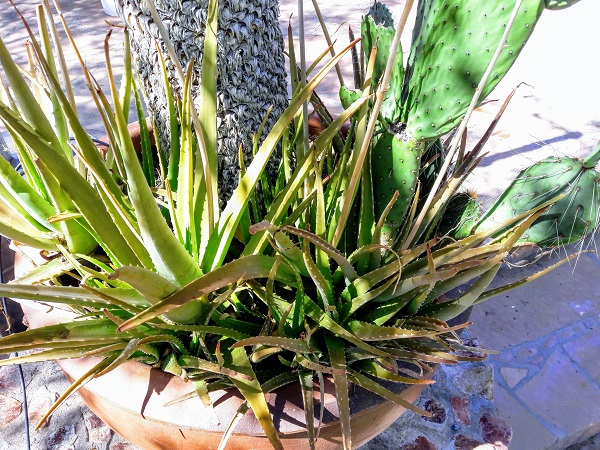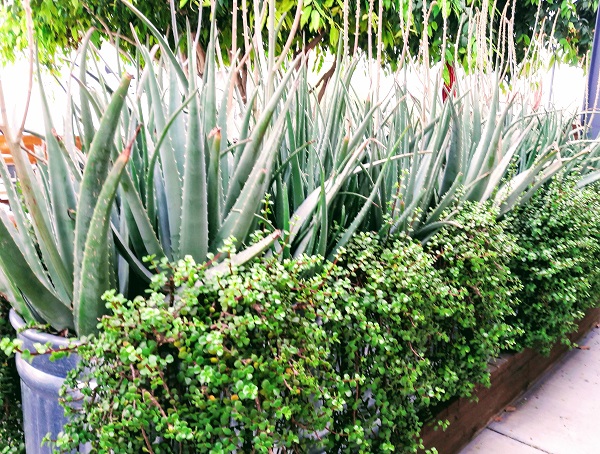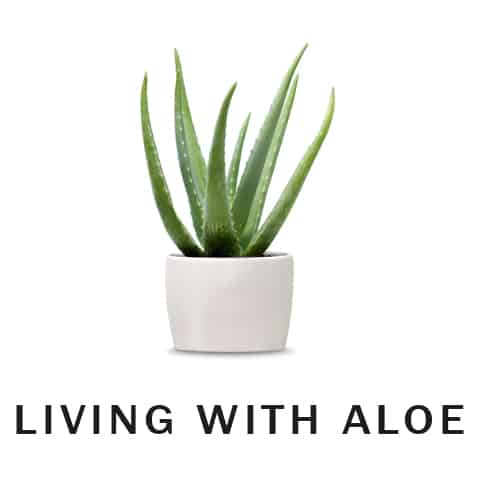
Most of us think that we have control over our universe. However, when we separate ourselves from nature, disastrous consequences often result. For example, exterminating pests with chemicals, such as pesticides and herbicides, keeps plants from flourishing. Discouraging self-seeding only increases problems with insects and disease.
Seeking Harmony
That is why you need to restore a balance in nature by implementing companion planting. You just need to know which plants go well with your aloe plant. Companion planting restores balance, so plants can be grown in harmony. In fact, everything in the plant world and in nature links itself to harmony. That is where you will find purpose in the growing of plants. Therefore, it is important to note that companion planting relies on balance, and therefore respect.
How Companion Plants Balance Out a Garden
Before you find just the right companion plants for your aloe vera plant, think how companion planting can enhance your gardening efforts.
Following are some of the benefits:
- Increases the production of edible plants.
- Increases the creation of nutrients, and therefore the manufacture of essential oils.
- Reduces the incidences of destruction by disease and pests.
- Attracts insects that are beneficial to your aloes.
- Nurses the damaged plants back to better health.
- Improves the overall health of your potted plants or garden
- Conditions the soil.
- Attracts more earthworms.
- Allows for autonomy among plants – the garden, over time, starts to govern itself.
- Enables you to contribute to a better environment overall.
- Creates natural beauty by balancing everything out.
Seeking an Ecological Balance – What to Remember
When selecting companion plants, too, remember the following:
- Make sure the companions are suitable for the environment in which they are grown.
- Placing the plants will be simpler if you know the growth patterns of species. This is helpful if you plan to rotate plants to prevent a disease build-up in the soil.
- Learn about any weeds that may hurt or injure your aloe or companion plants. Some of the weeds may attract certain pests.
- Seasons, especially in arid climates, don’t always reflect what is expected on the calendar. For example, official start-dates for summer may happen earlier than they do normally. If you want to transplant plants outdoors, find out the length of time for the local growing periods, or when more inclement weather may occur.
Now that you have an idea about the reasons for using companion plants and know some of the environmental points, you need to learn the four roles that companion plants hold.
How Companion Plants Even Things Out
Companion plants offer an ecological balance in gardening in one of four ways.
1. Camouflages. Some companion plants mask the fragrances of the plants that need to be protected from destructives pests. These plants may have an overpowering bouquet – one that confuses an insect, causing it to seek another plant for food. For example, some geraniums can be used to mask the odors of tomatoes.
2. Nurtures. Companion plants may also serve as nurses in the garden world. They attract nutrients from the soil to improve the health of surrounding plants. They also assist the other plants to recover from the effects of infestation and disease, and help them become more disease-resistant.
3. Detracts. Some companion plants actually attract the pests that can hurt a neighboring plant. Plant a decoy companion plant some distance from your aloe plant. That way, any infestation will not spread. For example, if you may plant some companion plants in a pot in a corner on the patio, place your aloe vera plants toward the middle.
4. Stimulates. Use stimulating companion plants to boost your aloe’s vitamin and mineral content, or enhance its growth. When these types of companions are planted aside each other, the whole garden bursts with life.
What to Pair with Aloe Vera
Some Common Companions
While a number of plants work out well, when planted alongside aloe vera, some of the more common plants included the following:
- Borage
- Scented geraniums
- Any plant from the onion family
- Sow thistle
- Balm of Gilead
- Elderberry
An Ideal Pairing
Using Aloe Vera Gel and Onion Juice for Hair Loss
If you want to use the benefits of aloe vera and its companion plant, plant aloe vera with onion. This combination of plants can be used to control hair loss and dandruff. After all, who does not want to experience silky and voluminous hair? If you or anyone else you know struggles with hair loss, dandruff, scalp irritation, or dull and brittle hair, using onion juice and aloe vera gel provides the perfect remedy for a natural scalp therapy.
Using the Companion Onion for Preventing Hair Loss
Not only does the pairing keep the plants healthy and growing, it also offers the following individual benefits. For example, the juice of an onion provides the following:
- Antibacterial and antiseptic properties – properties that fight dandruff or even lice. The juice from onions can be used as a conditioner and nourishers, as the juice kills the microbes that trigger hair loss.
- Onions contain sulfur, which reduces breakage. This same ingredient is needed for hair proteins, such as keratin, as well. Studies indicate that the ingredient contributes to positive hair growth.
- Because of its rich anti-bacterial properties, onions can be used to get rid of dandruff.
- Onions enhance blood flow, which also supports hair growth.
How Aloe Vera Helps People with Hair or Scalp Problems
When aloe vera gel or juice is used, it provides the following advantages:
- Aloe vera contains protein, which makes the hair stronger and smoother.
- The vitamin A contained in aloe vera produces a healthy production of sebum, or the oil secreted in the scalp. This oil prevents the hair from drying or breaking. The vitamin also fights the free radicals that tend to weigh the hair down.
- Vitamin B12 in aloe vera is good for the scalp. This vitamin is used to help regrow the hair.
- Vitamin C in aloe vera gets rid of scalp bacteria. It also wards off dandruff, and prevents itchy and dry scalps.
As you can see, when you extract the juices from these two companionable plants for your own use, or for commercial purposes, you have a winning team.
Hydrating the Skin with Aloe Vera
Recommended Companion Succulents

Besides planting aloe with onions, or onion relatives, you can also gain a good deal of benefits by pairing aloes with the following:
1. Aeoniums. Indigenous to the Canary Islands, these plants are evergreen succulents with beautiful rosettes that depict notable pinwheel leaves. Even when they are not showing off their star-shaped raceme type blooms, they are still striking.
Unlike other succulents, aeoniums are known to grow in the winter and remain dormant in the summer. The growth emerges at the rosette’s center. As the rosette becomes older, the outer leaves fall way, exposing the stem that supports the rosette. If you do not like the look of the stem, snap off the rosette under the lowest leaves within just one-half inch of the stem. Replant the cuttings and get rid of the denuded stem.
This succulent belongs to the Crassulaceae family, which makes up about 35 species of subtropical succulents. The plants come in varied sizes, colors, and shapes. Their foliage hues vary, depending on sun exposure, the sun, and the general climate.
You can grow this plant with aloe in a pot, as it can be grown in sandy, well-drained soil in the full sun. This plant, like aloe vera, also tolerates light shade. If the leaves are darker, the plant will be more sun-tolerant. While the plant resists drought well, it does require more watering than other succulents, as it features a shallower root system. Just make sure you cut back on the watering during the summer when the plant is dormant. This plant is almost pest-and-disease-free, with the exception, like aloe, of mealybugs or aphids.
Some of the aeoniums that work well in containers include the following:
- Aeonium zwartkop (which features large rosettes)
- Aeonium canariense (the Canary Island variety) – (leaves tinge reddish-pink when exposed to the sun)
- Aeonium haworthii (kiwi) (which shows off small and variegated rosettes)
2. Agaves. Native to the southern US, Mexico, northern South America, and the Caribbean, the agave is an evergreen succulent that showcases lovely rosettes and rigid and thick fleshy leaves, each highlighting marginal teeth and a sharp spine. The plants come in various sizes and colors and show off various leaf shapes. They add both interest and drama to a patio or desert landscape.
Use agave as a companion plant in the Southwest, as it thrives well in the garden. The plant, which is versatile, can be grown in containers or pots even in areas where it cannot overwinter. Grow the plant in sandy or gravelly media that is somewhat acidic. The soil should be well-drained. Agaves tolerate light shade when placed in hot Southwest gardens.
Drought tolerant, an agave can go without watering for months or even weeks. Just like the aloe, overwatering can trigger the spread of fungal root rot. Therefore, this companion plant can be placed next to an aloe vera plant without too much concern, provided you do not overwater either of the two plants.
One note of caution – never plant agaves with aloes near a walkway. The sharp spines of the plant’s leaf tips can hurt pets or people. These plants attract both birds and hummingbirds and keep away rabbits or deer.
The best times to plant agaves are in the early fall or spring. Make sure not to cover the leaf rosette with any soil, as it can lead to rotting. Until the plant becomes established, water it once or twice weekly.
3. Sedum nussbaumerianum (Coppertone stonecrop). Also known as the Coppertone stonecrop, sedum nussbaumerianum is a low-growing kind of evergreen subshrub with thick pointed leaves and lovely rosettes. When planted in partial shade, the leaves turn rose and gold – elevating in hues to copper-red in a full sun. In the spring, the plant exhibits clusters of round slightly-fragranced starlike flowers with pink anthers.
Plant the plant with aloe in a hanging basket or a large and decorative container. It also works out well in a succulent garden or rock garden. This easy-to-grown groundcover or low-growing succulent is best grown in full sunlight and a well-drained soil. While it tolerates the shade, its best hues are obtained when the plant is grown in full sun. Like aloe, you only need to water this plant occasionally.
Once the plant is established, it tolerates the heat and drought well. Therefore, it is a superb addition to a Southwest aloe and desert garden. The Mexican native will forgive you if you neglect it, as it is considered one of the lower maintenance succulents.
Some Stonecrop Alternatives You May Want to Consider as Well
Whatever type of stonecrop you choose, you will be well-pleased by its color and drama. Some of the alternatives you can add to your pots or desert garden include the following:
- Orange stonecrop (regarded as one of the best and popular sedums)
- Dragon’s blood, or sedum spurium (a gardening favorite)
- Sedum acre (also known as gold moss)
- Sedum spathulifolium “purpureum” stonecrop (an award-winning succulent)
- Sedum brilliant (another award winner and favorite plant)
Keeping Bugs Away from Your Aloe Plants
Any companion plants that you plant next to aloe in a pot or container should be at home in a sandy or gravelly media – one that drains well and prevents the plant from forming diseases, such as fungal root rot. Other plants, such as scented geraniums, can be planted in in separate containers and placed next to your aloe plants. These plants detract bugs from infesting your valuable aloe succulents.
Planting a Desert Oasis
If you want to plant a desert or succulent garden, without containers, the best plants to choose include the stonecrop plant, agaves, or aeoniums. Since all these plants come in various forms and shapes, you can enjoy a companion garden that is both free of pests and disease. The lovely blooms and colors of the plants will make any desert garden space a feast for the eyes and psyche.
